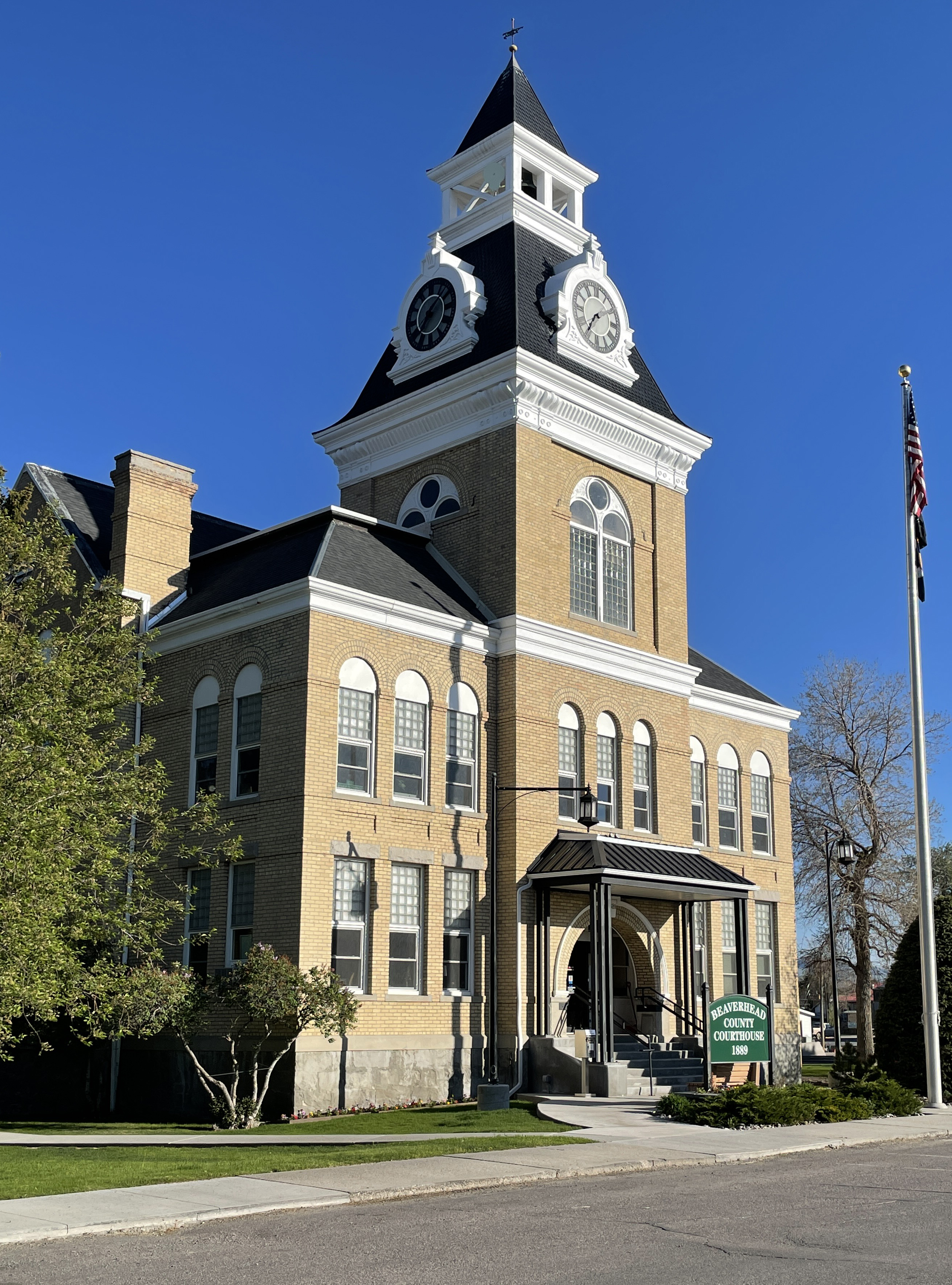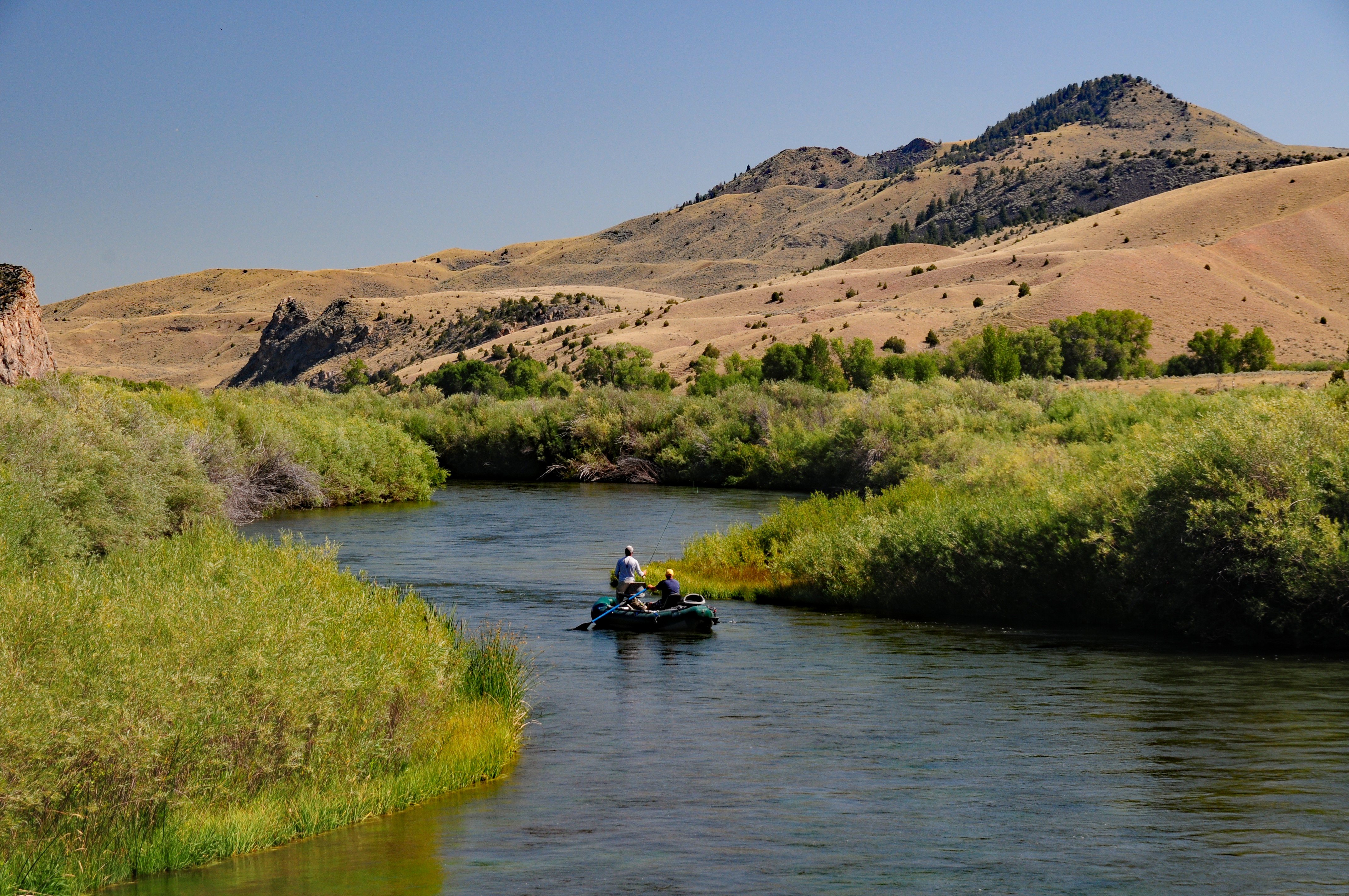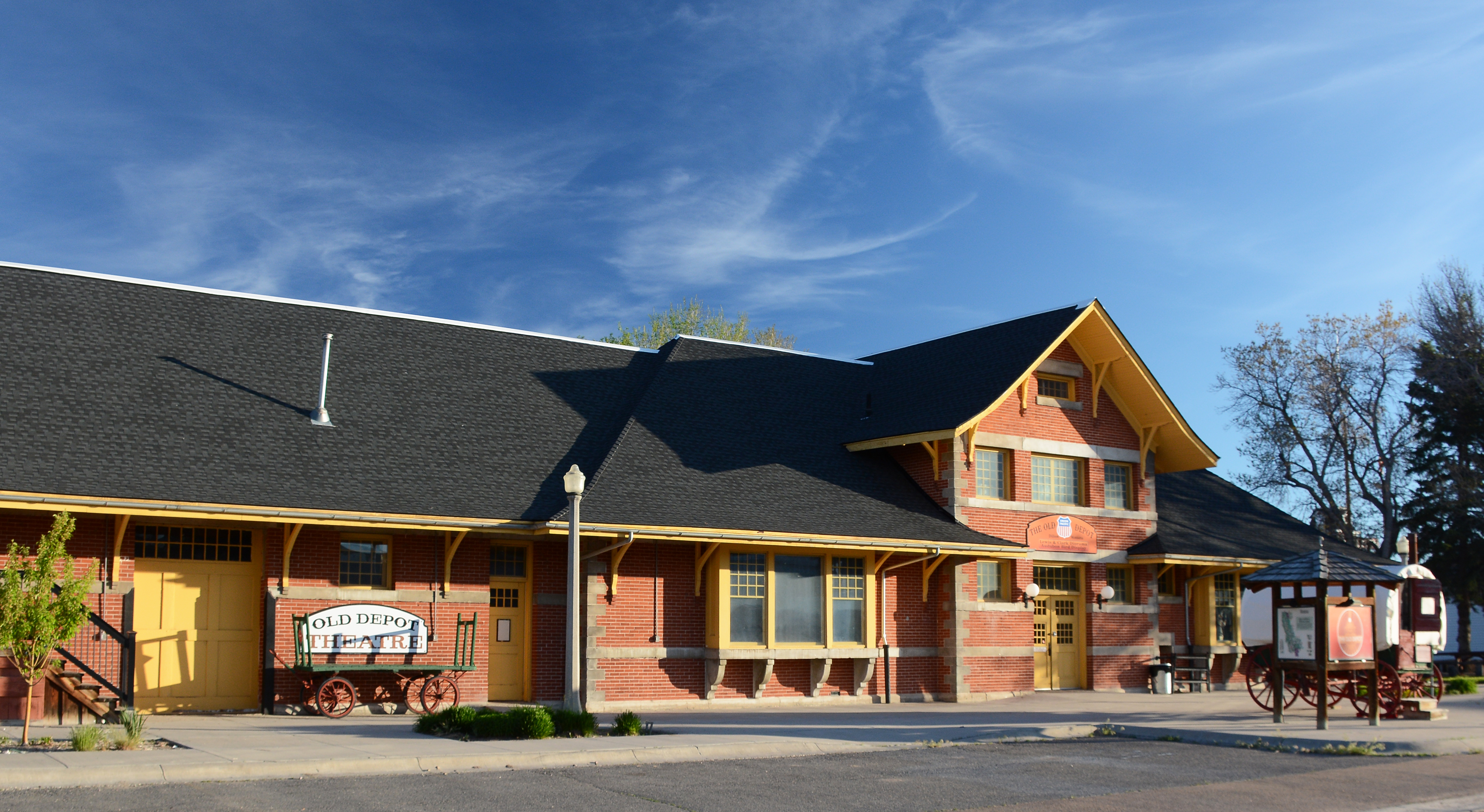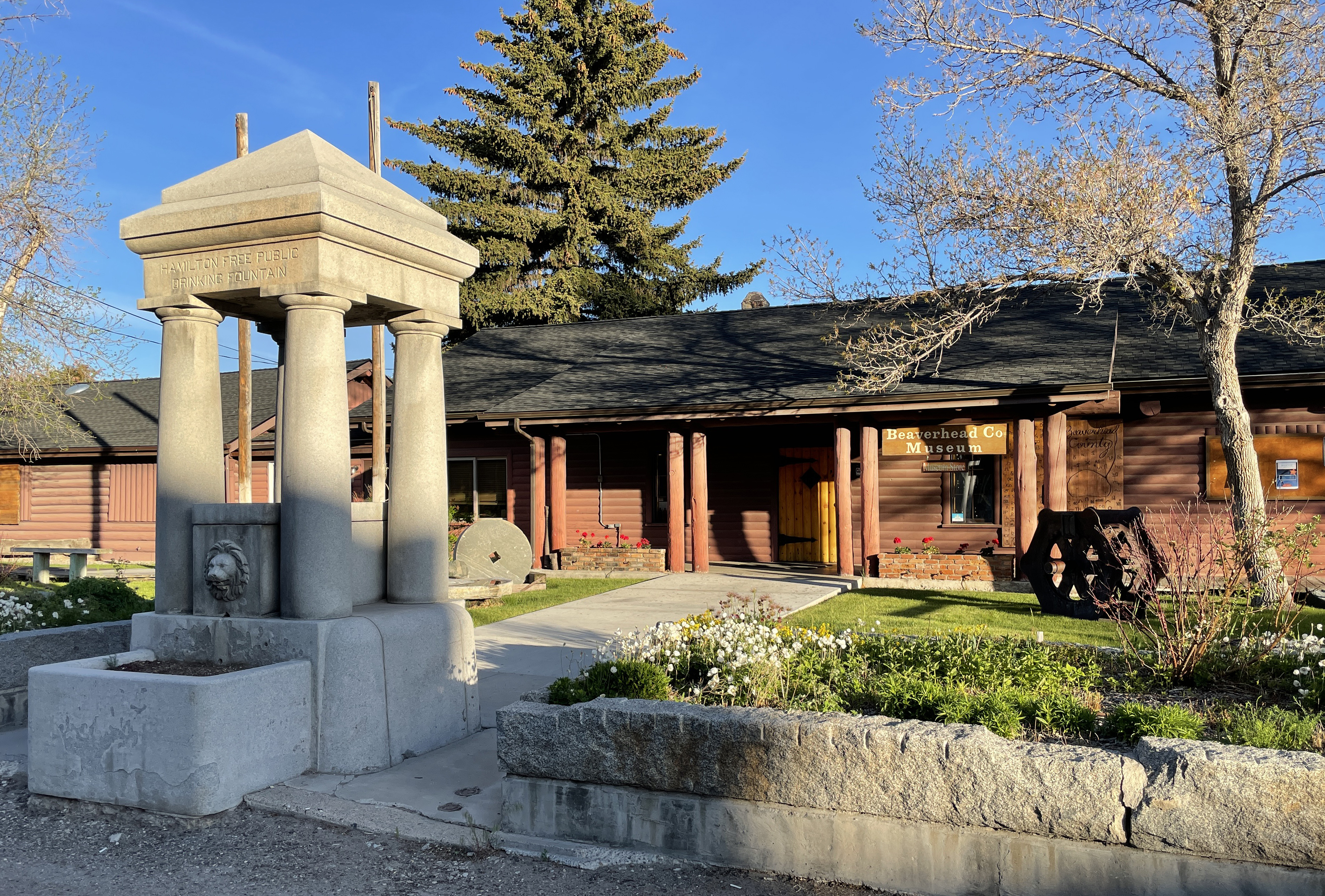Dillon: Capital of the Beaverhead
 Photo of Beaverhead County Court House by Rick & Susie Graetz
Photo of Beaverhead County Court House by Rick & Susie Graetz
By Mark Spero and Rick Graetz
Montana's southwest corner is a realm of lofty mountains, wide sagebrush, and bunchgrass-filled valleys, long on scenery and short on people. Sprawling ranches and public lands dominate. South of Butte, Dillon, population 4,300, in the heart of the Beaverhead Valley, is the only town of size in this part of the state. Folks living here have clear views of many mountains – eleven ranges in all. And the blue-ribbon trout stream, the Beaverhead River, touches its west perimeter.
Before Europeans arrived in the Beaverhead, Shoshone and Bannock tribes occupied the area as hunter-gatherers. The tribes were interrelated and shared many cultural characteristics with the Nez Perce tribe. Early fur trappers in Southwest Montana wrote about encounters with them, though they often confused the Bannock for the Shoshone and vice versa. Europeans introduced the Shoshone to horses, which became plentiful and a vital part of the tribe's culture and economy.
Eventually, the indigenous people were pushed out of their homelands and settled in southeastern Idaho as fur trappers they traded with were replaced by gold miners and railroads. The area that would become Dillon grew in importance.
A short way to the west of Dillon on Grasshopper Creek, on July 28, 1862, Montana's first gold discovery of note was made, giving birth to Bannack. Then in May 1863, the state's most prominent gold find happened in Alder Gulch, about 30 miles as the eagle flies to the east of this now seat of Beaverhead County. Virginia City quickly grew to a gold camp of 10,000 people.
Montana's first railroad, the Utah & Northern Railway, reached the Montana border on May 9, 1880, intending to terminate in Butte to provide shipping services for the booming copper and precious metals industry. Its tracks made it into the "Mining City" on December 21, 1881. But it paused in Dillon on its way there.
Dillon was created on September 13, 1880, when a group of businessmen purchased a 480-acre ranch. It wasn’t incorporated until 1884 and, at that time, named for the railroad's president Sidney Dillon. It was selected in part owing to its proximity to gold mines in the area. The new settlement was the temporary terminus of the steel road through winter 1880-1881.
Sidney Dillon and his access to capital helped the town flourish. He used Dillon as the center of a network of Montana railways that allowed for the easy export of agricultural goods. After he died in 1892, the town continued to thrive as an essential spur line and railroad depot.
As gold deposits were exhausted, the area became less critical for the railroads. Still, the town acquired a new railroad depot and remained influential as a stopping point for those traveling to Oregon. The city also remained a major exporter of talc from local mines and for a while was Montana's largest wool exporter. Rich grasslands of southwestern Montana valleys helped the place become the regional center of ranching. Its continued relationship with the railroad companies allowed Dillon easy access to markets outside the state, a plus for ranchers and farmers.
By the early 20th century, Dillon was home to a Carnegie public library, built with stone from nearby quarries, and the Montana State Normal College, now known as the University of Montana Western. Initially training teachers for the growing state, the college soon bloomed into a four-year university. When the school opened, it announced that "The citizens of Dillon have made every effort to secure good accommodations for the students."
A picturesque wilderness that captivated its many immigrants has remained the most crucial draw to this piece of Southwest Montana. And Dillon is the “base camp” to the area's magnificent gathering of peaks and verdant valleys and part of the 3.35 million acres Beaverhead-Deerlodge National Forest.
Skirting Dillon, the Beaverhead River attracts fly fishermen for its trophy-sized brown trout. In the Beaverhead and the Big Hole River, some of the few remaining native populations of fluvial Arctic Grayling are found. Called "white trout" by Lewis and Clark, the fish has become a rare sighting due to the introduction of other fish species and the encroachment of human settlements.

Photo of Fishing The Beaverhead by Rick & Susie Graetz
Above the Beaverhead River, Clark Canyon Reservoir holds the combined flows of Horse Prairie Creek and Red Rock River and its rainbow trout habitat. Fishing enthusiasts, boaters, and campers find their way to these deep blue waters. The Beaverhead is born from the waters coming from the dam’s outlet.
Just downriver from the reservoir, anglers and floaters encounter many twists and turns, with plenty of lush corners for fish to hide. Those who wade into this section of the river find easy solitude. The Beaverhead flows for sixty-nine miles, traversing hills and valleys, before making its way to join the Big Hole and Ruby rivers at Twin Bridges to form the Jefferson River.
Numerous other rivers and creeks, upwards of six, such as the Ruby and Big Hole carry the lofty status of “blue-ribbon” and make the area a fly-fishing magnet.
As Southwestern Montana has grown and developed, conservation organizations have stepped up to protect its natural resources. The Beaverhead Watershed Committee has created numerous projects to keep the valley safeguarded. The committee is dedicated to improving fish populations, removing noxious weeds, rebuilding riverbanks, and working with farmers and ranchers to clean the creeks and rivers.
Building walking and biking trails that are in harmony with natural surrounding has been the work of two Dillon nonprofits for many years. The Beaverhead Trails Coalition has undertaken land purchases and construction projects that connect Dillon, through a network of paths to surrounding public lands. And their work is aided by Bike Walk Southwest Montana, by educating people on the best routes for biking or walking. These folks have made Dillon a destination for bicyclists travelling cross country or in the region thru their bicycle camp. The site features a pavilion, camp areas, wash house, shower, and a shop for making repairs.
Dillon is well known for its wild surroundings, but it keeps one foot in its vibrant and colorful past, with many historic buildings and monuments, including its public library. Every year, people travel to experience the carefully preserved Old West sites and the monuments to the Corps of Discovery. For the past fifty years, the old railroad depot has housed Beaverhead County Museum. Chronicling the area's important history, the museum recognizes how Dillon's role as the county seat and railroad hub has allowed Southwest Montana to grow. The community has dedicated its time and energy to the museum, keeping the history relevant and accessible through a devoted group of volunteers and supporters.
It might be said with a good deal of accuracy that this region was the foundation of today's Montana. Nothing of importance was happening in Montana until that day in late July when the sound of eureka echoed across the west and nation. Gold was found in southwest Montana!

Photo of The Old Depot by Rick & Susie Graetz
Even as various industries have faded, Dillon has grown and thrived. Ranchers still rely on the grasslands, and the remaining railroad routes still help the area ship its agricultural products. Its proximity to mountain ranges and rivers has made it a hub for outdoor recreation and has attracted one of the few Patagonia outlets in the United States to its historic downtown.
Helping anchor the town, the University of Montana Western is a small, comprehensive university with an integrated two and four-year mission, offering certificate, associate, and baccalaureate degrees in education, business, and the liberal arts. It is the only public university in the United States that utilizes the program Experience One, where students take one 4-credit course, three hours a day for 18 days (3.5 weeks), then have a four-day break before moving on to the next subject. Taking four courses or "blocks" during the semester earns the same amount of credit as traditional multiple class systems.
Since 1922 Dillon’s Barrett Hospital and Health Care, has provided Beaverhead County with outstanding care. For the past couple decades, the hospital has been constantly updating its facilities. More than 260 employees make the hospital Dillon’s largest employer.
Dillon is also home to the Beaverhead-Deerlodge National Forests' Supervisor's office. Its 136 permanent staff making it another major contributor to jobs in the area.
Talc mining is also an important factor in the Dillon economy and Barretts Minerals employing about 100 workers has been part of the community since 1992.
Southwest Montana is considered the most mineralized region of Montana. Here is where the first gold, silver and copper in any quantities was discovered. This province also features wide-spread exposed areas of the Pioneer Batholith, an igneous intrusion into the original sedimentary rocks that have since eroded away. The name comes from the rounded fractured boulders that are typical of this type of terrain. Batholiths are directly associated with mineralization.
Through UM Western, Dillon has become a center for experiential learning with geology being a lead discipline.
Summer geology field camps have been taught using facilities at the college since the 1960s. Today, the region is a mecca for up to thirty geology field camps from all over the world. The area attracts these universities because the geology is incredibly well exposed, covers all of the different rock types and structures that are important for students to see in the field, has easy access to public land with minimal elevation and is located in a university town that provides campus access to classrooms, computer facilities, food service and dorms.
Geology camps start arriving in Dillon as early as mid-May and continue through the fall. Each camp has a different duration of time they spend in town, but a typical geology field camp lasts for five weeks, with the students working in the field for a minimum of six days per week The camps are a source of renewable revenue for the Montana Western campus and the Dillon community.
Perhaps the best-known event in Dillon is Montana's Biggest Weekend, held every September. The Dillon Jaycees organizes the event. It includes a rodeo, a concert, carnival attractions, and presentations by 4-H Clubs. Significant draws are other popular happenings like the Summer Kickoff Concert, the Demolition Derby, and the Labor Day Parade.
To those traveling Interstate 15 and who have not spent time here, Dillon may seem like just one more town off the highway. Here, however, is a place well-worth visiting and staying for a spell. One look at a topographic map with Dillon as the center point shows in all compass directions, just what a very exceptional gathering of geography this community provides access to.
Eleven mountain ranges, the Beaverhead, East Pioneers, West Pioneers, Tendoy Lima, Red Conglomerate, Centennial, Blacktail, Ruby, Snowcrest, and Tobacco Roots, with others not much further away have some of the interior west's most splendid high-country scenery and all that comes with elevated terrain.
Nearby a forty-nine-mile-long road, Pioneer Mountains Scenic Byway passes numerous trails on the national forest and historical sites such as the ghost town of Coolidge and the abandoned Elkhorn silver mine. In the winter, it becomes a snowmobile trail, allowing riders to cross blankets of snow and experience the beauty of the forest as it sleeps. And its southern reaches give access to gems such as Elkhorn Hot Springs and the Maverick Mountain Ski Area.
Off the beaten path, the ski area is a favorite for the people in Dillon and others around Grasshopper Valley and beyond. Unlike many modern resort-style ski areas, Maverick Mountain slips neatly into the communal feeling of this corner of Southwest Montana.

Photo of Beaverhead County Museum by Rick & Susie Graetz
Other mountain routes out of Dillon provide entry to seemingly countless areas to fish and camp. The Blacktail Deer Creek Road passes through broad valleys edged by mountains and leads to the beauty of the Centennial Valley and Red Rocks Lake National Wildlife Refuge, home to the endangered Trumpeter Swan. Along the way, roads point into the backcountry of the Snowcrest Range.
Montana Highway 278, climbing out of the Beaverhead Valley from Dillon, crosses Badger Pass on its way to the Big Hole Valley and fabled Big Hole River.
Tweedy and Torrey peaks 11,154' and 11,147', in the heart of the loftiest reaches of the East Pioneer Mountains show some of the west's finest alpine settings. Three lake basins are cradled below their steep walls, and the hard igneous rock of these massifs allows for excellent mountaineering possibilities. It is a hidden treasure for rock climbing and backcountry skiing, with few people to interrupt an experience of solitude, lost elsewhere in our modern, mechanized world.
A short way out of Dillon to the west, Bannack, Montana's first territorial capital and now a preserved – it's called arrested decay - ghost town is frozen in its Old West heyday. It is now a Montana State Park.
And there is more, much more to see.
In this peaceful landscape setting of Dillon and its surrounding environment, there is a strong sense of pride in place, and all that antiquity has bestowed on it. It is unique in the American mountain west.
No grandiose signs on the roadways exclaim this; instead, one needs to ease off the Interstate and realize why, and to do so will prove to be an excellent investment of time.
